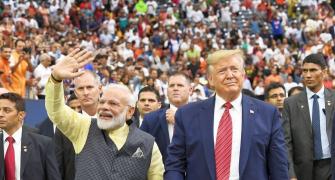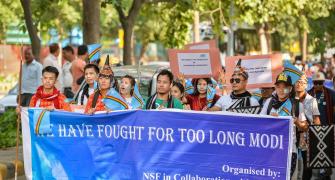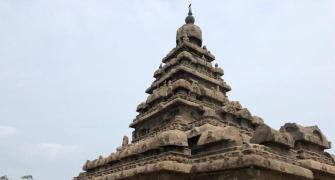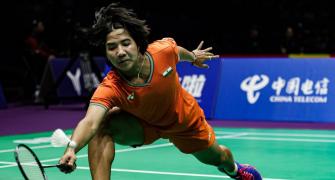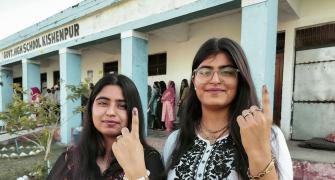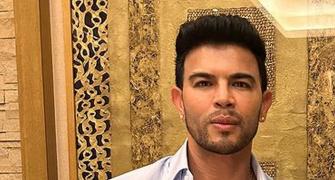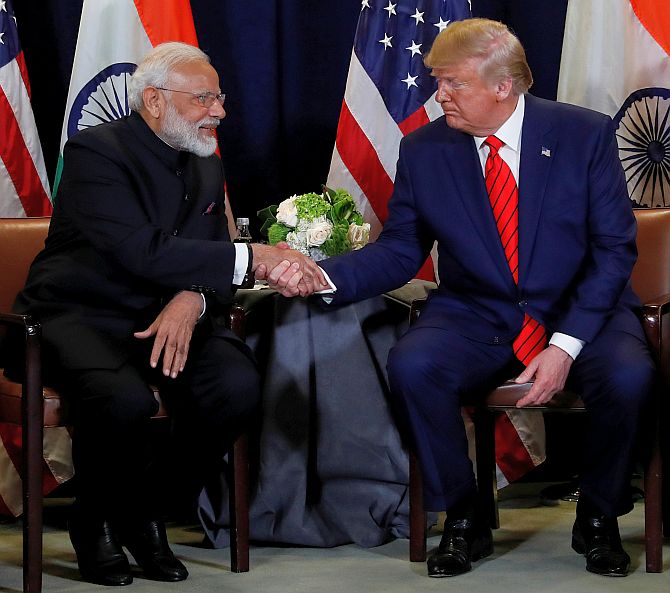The close-onto four years (since November 2015) Peter has spent in Arthur Road jail, central Mumbai, in judicial custody, have taken their toll, lending him a bit of a melancholy stoop, a laborious gait and a tired face, turning him prematurely into a much older man than his nearly 64 years.
Vaihayasi Pande Daniel/Rediff.com reports from the Sheena Bora murder trial.
Illustration: Dominic Xavier/Rediff.com.

It was a frailer and unhappier Peter Mukerjea, former CEO of Star India, who showed up in the Mumbai city civil and sessions court, Kala Ghoda, located near the Oval Maidan, in south Mumbai, after a 27-day gap on Friday, September 27, 2019.
He was still moving slowly, using his four-footed cane.
Not only was his chest, even till date, trussed up in a grey band, that is actually a chest brace to protect his healing ribs and thoracic cavity post his massive March bypass surgery, on Friday his neck was in a brace too, a pink one.
The man has aged many more years than the two and a half one has seen him for, while reporting on the Sheena Bora murder trial.
The close-onto four years (since November 2015) Peter has spent in Arthur Road jail, central Mumbai, in judicial custody, have taken their toll, lending him a bit of a melancholy stoop, a laborious gait and a tired face, turning him prematurely into a much older man than his nearly 64 years.
You don’t need an official report of the state of undertrial prisoners in India to know the reality of their status.
You only have to look at Peter’s countenance, a man occupying one of the best cells in the country’s jails (best a word which is perhaps arguable or maybe not necessarily implying much), where he might be joined by several other projected high-profile economic offenders (maybe a former CM, who knows?), to know the scale of suffering.
How much more incredibly worse must it be for small-fry, voiceless, powerless undertrials, living for years together in oblivion, in some rat-hole of a prison waiting for a trial date that never comes?
Reports in the paper about former finance minister P Chidambaram lacking a chair or a pillow in Tihar, Delhi, are not frivolous as solicitor general Tushar Mehta has unkindly stated. If the nation’s currently most high-profile prisoner, an elderly man, lacks these basic amenities, can we even imagine what the rest don’t have or are inflicted with?
All these undertrials are people not yet proven guilty, mind you. They are enduring, unfairly, endless jail terms, long before the actual terms have been handed out to them. Tomorrow they could be either you or me. We don’t need to commit a crime to be there.
Peter aka Accused No 4 was a late arrival at the Friday hearing, because the queues for the court lifts are enormous and when he finally found his place at the back, he looked morose and sad, as he sat down carefully and stiffly in a chair, in the rear of the courtroom.
He came across, maybe, as slightly discombobulated too, which perhaps comes with the terrain for any accused who have been that long in jail -- baffled, confused when they think about the terribly unreal nature of their fate.
Peter, after the hearing was over, shambled to the front of the courtroom and entered the witness box, his face drawn, to announce dramatically to CBI Special Judge Jayendra Chandrasen Jagdale words to this effect: "Your Honour, I fear I do not have long to live."
The judge asked him not think that way and in his kindly way tried to offer assurances.
But more on that later -- first a summary of the Friday proceedings.
September had nearly whizzed past without a single hearing in the Sheena Bora murder trial.
The next hearing might have easily been in October had Maharashtra’s former chief minister, India’s former defence minister, and NCP leader Sharad Pawar decided to journey from his house in Breach Candy to the office of the Enforcement Directorate at Ballard Estate, both in south Mumbai, to turn himself in for questioning in a graft case, as he had threatened.
Fearing total chaos the Mumbai police slapped down orders preventing the gathering of more than four persons under Section 144 of the CrPc in various areas of south Mumbai, planned heavy police bandobast (security ring) and then persuaded Pawar to stay home and not step out, as he had angrily declared.
And so the September 27 hearing in the trial unfolded smoothly.
Much about the process of a trial -- that takes itself clearly out of the hands of anyone trying to speed up a case being heard in court -- hinges on the availability of guards, or specially-assigned policemen/women, to bring the masses of accused from crowded jails to courts in overdue trials. And in a city like Mumbai, with its enormous population, the army of khaki, is needed for myriad activities, be it VIP security, rescue during deluges or festival safety.
Hearings were not feasible through the first half of September because much of the city’s police force was on Ganesh Puja duty. A slew of back-to-back holidays also threw the court scheduling into disarray.
On Friday, Peter now in a double brace was not the only new development for the circle of people, like a mini, higgledy-piggledy-formed Family of Courtroom 51 -- guards, lawyers, clerks, peons, the cat, the journos, prosecutors, the judge, the accused, the relatives, not to forget the deceased -- associated with this trial and now quite familiar to each other.
The arrival of the newly-appointed CBI Special Prosecutor on the case, the moustachioed and mildly graying Manoj Chaladan, was another surprising change.
Chaladan, who hails from Kerala and has worked earlier in the Narendra Dabholkar murder proceedings and other cases in Pune, took over the case -- the third prosecutor for this trial -- from Ejaz Khan, who perhaps had too large a caseload to continue.
A quiet man, it would seem, Chaladan is of medium height and trim build, who according to his Twitter feed appreciates, equally, figures like the Dalai Lama, the Sadhguru (Jaggu Vasudev) and the pope.
The PP was still grappling with his new ropes on Friday, bravely taking charge of a complicated four-year-old case, that has hundreds of witnesses and has been in court since February 2017, now under its second judge.
Prosecution Witness No 58 Dr Shailesh Chintaman Mohite, professor and head of the department of forensic medicine at Topiwala National Medical College and the attached BYL Nair Hospital, returned to the stand Friday.
The good doctor, wearing a white, long-sleeved shirt, grey trousers, black and white glasses and a clutch of pens, it appeared in the last hearing, was going to be spending many more days in the witness box speaking about the bones of the skeleton said to be Sheena Bora’s, found, in 2012, at a till-then-unheard-of village in the interior of Maharashtra’s Raigad district. But Friday he wound up his ‘testimony in chief’ after giving his opinion in court on just four more sets of bones.
Four further large, light green envelopes debuted in Courtroom 51, which Dr Mohite opened very cautiously and methodically, providing, precisely, every detail to the judge as he proceeded, like if they been sent from Khar police station or elsewhere, the colour of the internal and external envelopes and the handwriting on the envelope (some of the bones had been sent for analysis to Delhi’s All India Institute of Medical Sciences it had been revealed last time).
So efficiently in tune with the judicial procedure was Dr Mohite that he was a one-man forensic-orthopaedic show (reminding one of the lyrics of the song Dem Bones that teaches children the nature of the skeleton), functioning in a well-organised, non-stop manner, without even a pause, as he processed bag after bag of chillingly rattling bones.
Post the initial envelope opening ceremony, he would pull out each plastic bag of bones, sometimes dipping his hands in to extract one bone or another to show to the court or absent-mindedly fingering them, all the while consulting his report to provide continuous commentary about the bones, spelling every third word, in a windfall for the court stenographer (“ribs, r-i-b-s”, “these, t-h-e-s-e”, “were, w-e-r-e”, “hip, h-i-p”), hardly needing Chalandar’s initial “spelling batao” prompt!
“… Twenty-four vertebrae present and our impression was that all these vertebrae belong to the same individual as there was no repetition and they were snugly, s-n-u-g-l-y, fitted with each other. Impression age was less than 25 years…”
“… Hip bones marked. So too sacrum (located at the base of the lumbar vertebrae). After examination our impression was, in view of the above features, both hip bones and sacrum to a female. Impression about age was age is more than 21 years and less than 25 years... ”
Friday, from neck down, the rest of the skeleton, who is meant to be Sheena, emerged.
Sadly, if it was Sheena, we got to know the dimensions and state of nearly every bone she ever possessed -- ‘nearly’ being a key or vital word here.
The ribs, mandible, the vertebrae, the sacrum, hip bones and finally the fibula and tibia of the lower legs were unveiled.
Yellowy-brown, the bones, which clattered disturbingly, even if they belonged to a petite woman appeared delicate and much tinier than one would have thought. The hip bones were rather small and the leg bones so fragile and dainty, almost Lilliputian-looking.
Dr Mohite’s epistle about Sheena’s bones seemed to end rather abruptly (one had been given the impression by the earlier prosecutor that bone itemisation would take quite some time because it was after all a whole skeleton), after these last four bags were catalogued. Dr Mohite was ready to launch into his conclusions.
The doctor looked eager to offer his findings to the court and was also maybe a little surprised that they were not needed: “Shall I read the two-page report which is based on (a whole set of) conclusions drawn by us (his Nair team) about the skeleton examination?”
Both the judge and Chaladan said it was not necessary. Perhaps the conclusions would not work in the prosecution’s favour. One could only guess.
Dr Mohite offered to summarise the report and was granted that opportunity.
He then rattled off for the next five minutes the highlights. The critical bit was this: “All the bones belong to a single individual, are of female sex, age being 22 to 25 years and the stature was 154 cm to 160 cm (Sheena was said to be short and looked so in pics). The cause of death cannot be detected in absence of any injury, fracture foreign, f-o-r-e-i-g-n body (bullet?), bone tumours and in absence of laryngeal cartilages and the hyoid bone.”
In the event of a death being due to strangulation, it has been discussed in previous witness testimonies, in this case, the laryngeal cartilage and hyoid bone (in the neck) might provide the possible evidence. But for some reason the parts of the skeleton Dr Mohite saw (we don’t know finally what came out of the ground in Raigad when the skeleton was found in 2012) did not crucially include these bones/cartilage.
Dr Mohite also had importantly suggested, via the conclusions of his report, at that time, firstly that a histopathological examination of some of the bones that were burnt and the broken humerus (of the hand) be done. Secondly he suggested that a proper dental examination was required and “correlated with past dental records” because “two empty sockets on the left side in the mandible indicative of a congenitally missing teeth.”
The judge, his brows furrowed, his face very serious, first asked if any histopathological report had also been done or was available.
Chalandan said he did not know and would find out.
About the dental examination he asked Chalandan: “No such thing? Whether you have collected such a report? The investigating officer should be present!.”
The prosecutor again murmured something about how he would look into it.
Once the doctor was done, the first week of October was chosen to start his probably lengthy cross examination -- Indrani Mukerjea’s trial lawyer Sudeep Ratnamberdutt Pasbola would kick it off.
But before Dr Mohite stepped down from the witness box for the day, Indrani’s lawyer Gunjan Mangla requested the judge if she may ask one question of the doctor.
Mangla, who was perhaps testing the future ‘cross’ waters, asked, with an odd quizzical expression on her face: “Kindly tell us how many kinds of registers were maintained at your department (at Nair hospital where the post mortem on the bones was conducted)?”
Dr Mohite answered very definitively -- giving an early flavour of how the cross-examination will proceed in October -- that he could not but was able to describe the various types of registers to Mangla.
Indrani, in dark blue and red, sindhoor in her hair, which was tied back in a ponytail, took the witness stand.
Speaking very softly, as she usually does in the box, she outlined to the judge at what stage they were stuck in the compliance process for her and Peter’s divorce proceedings – they are still not divorced; getting a divorce in jail is no speedy job, one discovered.
The bank/banks required her British passport and Overseas Citizen of India document to open her new account, that would no longer be joint with Peter. She also needed documents to do her KYC. They were not in her possession.
Judge Jagdale wondered if they were with the CBI, but Indrani corrected him saying she believed they were with the court.
She then tentatively and respectfully asked: “Your Honour, my bail application has been pending for six months.”
The judge was horrified to know she had not got a reply and looking at Chalandan declared she would get a reply next week.
Indrani then requested permission to speak to “Accused No 4.”
The judge didn’t understand her and she re-phrased her request several times, finally saying in an almost shy, hesitant tone, “Pratim.”
Peter had actually taken the stand before Indrani to talk about, what he felt, was his approaching death. The upshot of his statement went like this:
“I don't know how long I will live. I would like to speak to my children. One of them (Rahul, his younger son from his first marriage) is the main witness in the case and I have not spoken to him for 3 or 4 years... One is living abroad, in the UK (Rabin Mukerjea). Would like to speak to them on the phone in presence of the jailer (or whoever). Not spoken to them... Would like to speak to the (people) close to me…” he trailed off looking close to tears.
Judge Jagdale firstly pacified him: “You will have a long life.”
Peter: “By your grace.”
Judge Jagdale smiling, but taken aback: “No, no, it is not in my hands. My own life is not in my hands.”
The judge said he would look into organising for Peter to speak to his sons. He once again promised Peter that the permission for his small table would be coming through and he could get a dental check up in Andheri (north west Mumbai), which Peter had also asked for.
Judge Jagdale added that he would be visiting the jail: “I will be there in a few days.”
The Sheena Bora murder trial will resume one day after Dusshera, the day when good is said to conquer evil, on October 9.

